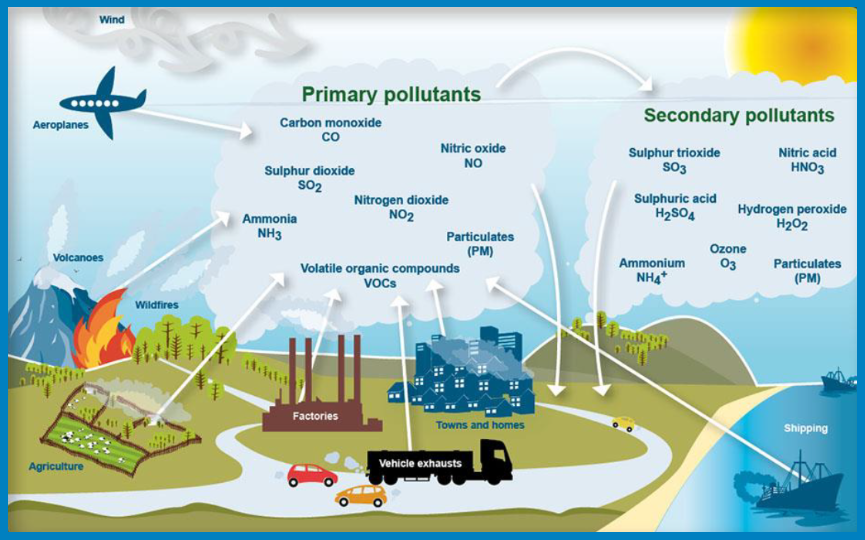Air Quality Campaign - Europe and Eurasia
GLOBE Europe and Eurasia Air Quality Campaign

The Europe and Eurasia (EE) Air Quality (AQ) Campaign is coordinated by the Europe and Eurasia Air Quality Collaboration Group, with support from the GLOBE Europe and Eurasia Region Coordination Office. Launched in 2022, this initiative helps GLOBE Country Coordinators, teachers, and students to engage in air quality observations and take action.
The campaign’s objectives include
- Motivate and support Country Coordinators and citizen scientists involved in air quality initiatives in their countries
- Encourage GLOBE educators and citizen scientists to participate in the AQ Campaign and join related events
- Facilitate international student collaborations focused on air quality and support student research efforts
- Organise an annual Europe and Eurasia Student AQ Conference in cooperation with the GLOBE EE RCO
- Explore opportunities to advance the development of PM and NO₂ GLOBE protocols
- Identify scientists and subject matter experts to get involved and provide expertise for the Campaign
- Share good practices and useful resources

Countries Involved in the Collaboration Group
- Ireland (lead)
- The Netherlands
- France
- Malta
Focus topics
Equipment needed: Diffusion Tubes (Palmes Tubes)
Suppliers
- Gradko (UK)
- Buro Blauw – approx. €18 per tube (includes analysis); bulk orders reduce cost.
Related GLOBE Protocols: Clouds, Rainfall, Air Temperature, Wind Direction, Humidity
Why Measure NO₂
Nitrogen dioxide (NO₂) is a key air pollutant primarily emitted by vehicles, power plants, and industrial activity. It can irritate lungs, worsen respiratory diseases, and contribute to smog and acid rain. Long-term exposure poses serious health risks and harms the environment.
How to Measure
- Install diffusion tubes in selected locations for four weeks
- Mark traffic hotspots and wind direction
- Collect adjacent traffic volume data
- Observe weather conditions following GLOBE protocols
- Send tubes to a lab for analysis
NO₂ is measured in micrograms per cubic meter (μg/m³), providing an average concentration over the measurement period.
See more details in this presentation.
Student Activities and Projects
- Impact of the School Run on Air Quality in Mt. St. Michael Secondary School, Rosscarbery, Co. Cork - IVSS Project
- Mt. st. Michael, Roscarberry, Ireland - poster
- An international comparative study of nitrogen dioxide levels recorded at schools in Malta and Ireland, Kishoge Community College, Ireland - IVSS Project
- How can we improve air quality at our school and its surroundings?, Gozo College Sannat Primary & Special Unit, Malta - IVSS Project
- “Analyzing Air Quality in Two Different Location in the Same Village”, Gozo College, Rabat Primary School, Malta - IVSS Project
- Clean Air Matters: A Study on the State of our Atmosphere, Gozo College, Middle School, Malta - IVSS Project
- Rathdown school, Cork, Ireland - poster
- Roscommon Community College, Ireland - presentation
- St.Mary’s Macroom School, Ireland - presentation
- Science club of Collège Jacques Mauré Castelginest, France - project done by 12 to 15 years old student - video and poster
Equipment options
- Clarity Node-S sensors (Know Your Air)
- Sodaq AIR sensors (Sodaq) – minimum order: 50 units
- PM Kit (developed locally)
Related GLOBE Protocols: Clouds, Rainfall, Air Temperature, Wind Direction, Humidity
Why Measure PM
Particulate matter, especially PM2.5, consists of tiny solid or liquid particles from exhaust fumes, industry, burning wood or coal, and natural sources. These particles can penetrate deep into the lungs, affecting heart and respiratory health. PM pollution also contributes to smog and environmental degradation.
PM is one of the most harmful pollutants—estimated to reduce life expectancy in Europe by nine months on average. Monitoring helps identify pollution hotspots and inspires action to reduce emissions.
How to Measure PM
Install one of the sensors and study the outcomes in connection to GLOBE Atmosphere observation. You can even install the monitor on a bike and let students explore air quality while on the move!
See more details in this presentation.
Student Activities and Projects
-
A comparative study on air quality at St. Michael School, Ireland - IVSS Project
-
The particulate matter around different elementary schools, Leidsche Rijn College, Netherlands - IVSS Project
Equipment needed: Calitoo Sun Photometer
Supplier:
-
Tenum
-
CNES can also borrow the Calitoo to start working with the sensor
Related GLOBE Protocols: Aerosols, Clouds
Why Measure Aerosols
Aerosols are tiny particles suspended in the air from natural (volcanoes, sea spray, dust) and human sources (fossil fuels, agriculture, industry). They impact air quality and health and play a major role in climate by influencing how much sunlight reaches the Earth’s surface. Aerosol concentrations can vary daily, seasonally, and due to events like dust storms or forest fires.
How to Measure Aerosols
Students measure Aerosol Optical Thickness (AOT) using a photometer to determine how much sunlight is scattered or absorbed by aerosols. These observations support satellite data comparisons and long-term climate studies
Follow the GLOBE Aerosols Protocol.
See more details in this presentation.
Student Activities and Projects
- Lycée de la mer, site de Biganos, France - presentation (in French)
Europe and Eurasia Air Quality Campaign Events
Invitation to the uproming student event
The Student Air Quality webinar, Wednesday, 11 March, from 11:00 to 12:30 CET. The webinar is open to all countries in our region, and students may join either as spectators or as presenters. If you need more information, please contact Air Quality team at globe@eeu.antaisce.org
- Register to attend the webinar
- Student presentation application: Here is a form for teachers/coordinators to complete if there is a student group that wishes to present Air Quality story at the webinar. Please complete the form by February 25th.
The Air Quality Collaboration Group has organised various events to promote student engagement and teacher training including:
- Presentations and workshops at EE Region Meetings: Croatia (2022), Latvia (2023), Slovenia (2024)
- Student-focused events:
- Air Quality Expert Webinar 💻, 18 November, 14:00 CET (13:00 Irish time)
- March 11, 2026: GLOBE Europe and Eurasia Air Quality Student Conference
- April 3, 2025: GLOBE Europe and Eurasia Air Quality Student Conference – read more
- November 28, 2024: NASA/GLOBE Ireland Student Webinar - see recording
Stay Connected
Contact us to Learn More and Cooperate
- GLOBE Ireland: globe@eeu.antaisce.org
- GLOBE Netherlands: Dorien@globenederland.nl
- GLOBE France: estelle.raynal@cnes.fr
- GLOBE Malta: ramona.mercieca@ilearn.edu.mt
- GLOBE Europe and Eurasia Coordination Office: ee.region.globe@gmail.com





